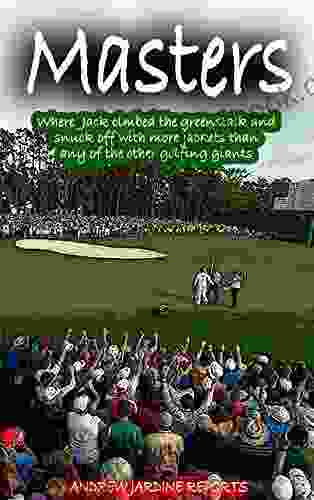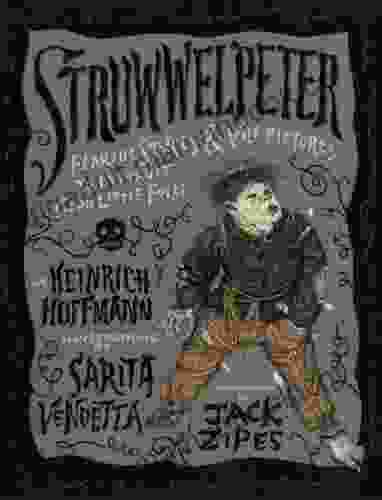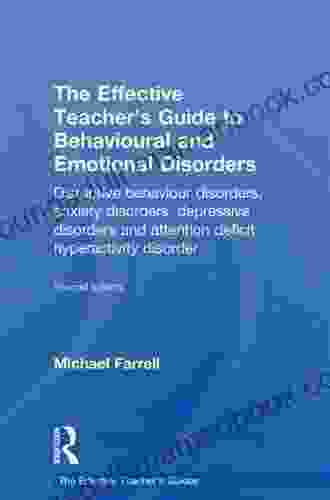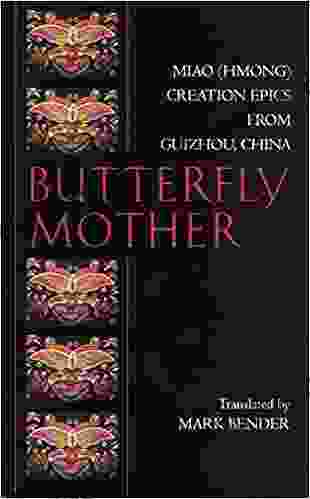Understanding Disruptive Behavior Disorders, Anxiety Disorders, and Depressive Disorders in Children

4.2 out of 5
| Language | : | English |
| File size | : | 482 KB |
| Text-to-Speech | : | Enabled |
| Screen Reader | : | Supported |
| Enhanced typesetting | : | Enabled |
| Word Wise | : | Enabled |
| Print length | : | 138 pages |
Mental health disorders are a major concern for children and adolescents, affecting their overall well-being, academic performance, and relationships. Among the most common mental health disorders in children are disruptive behavior disorders, anxiety disorders, and depressive disorders. These disorders can cause significant distress for children and their families, and it is important to understand the symptoms, causes, and treatment options to ensure effective support.
Disruptive Behavior Disorders
Disruptive behavior disorders are a group of conditions characterized by persistent and severe aggressive or disruptive behaviors. These behaviors can include physical aggression, verbal aggression, property destruction, and oppositional defiance. Children with disruptive behavior disorders often have difficulty controlling their impulses, following rules, and interacting appropriately with others.
There are three main types of disruptive behavior disorders:
- Oppositional Defiant Disorder (ODD): Children with ODD display a pattern of negative, defiant, and argumentative behavior towards authority figures. They may refuse to follow rules, argue constantly, and show disrespect.
- Conduct Disorder (CD): Children with CD engage in serious rule-breaking behaviors, such as aggression, property destruction, and theft. They may also show a lack of empathy and remorse for their actions.
- Intermittent Explosive Disorder (IED): Children with IED have frequent episodes of impulsive and aggressive behavior. These episodes may be triggered by minor provocations or stress, and can result in physical harm to others or property.
Causes of Disruptive Behavior Disorders
The exact causes of disruptive behavior disorders are not fully understood, but a combination of genetic, environmental, and social factors are thought to contribute to their development. These factors may include:
- Genetic factors: Studies have shown that children with a family history of disruptive behavior disorders are more likely to develop these disorders themselves.
- Environmental factors: Children who experience abuse, neglect, or trauma are at increased risk for developing disruptive behavior disorders.
- Social factors: Children who are exposed to violence, bullying, or other forms of social stress are more likely to develop disruptive behavior disorders.
Treatment for Disruptive Behavior Disorders
Treatment for disruptive behavior disorders typically involves a combination of therapy and medication. Therapy focuses on teaching children how to control their anger, manage their emotions, and interact appropriately with others. Medication may also be used to reduce aggression and impulsivity.
Anxiety Disorders
Anxiety disorders are a group of conditions characterized by excessive and debilitating fear, worry, and avoidance. Children with anxiety disorders may experience intense anxiety about specific situations, such as social situations, school, or certain objects or animals. They may also worry excessively about the future and experience physical symptoms such as sweating, heart palpitations, and muscle tension.
There are several different types of anxiety disorders in children, including:
- Generalized Anxiety Disorder (GAD): Children with GAD experience excessive worry about multiple aspects of their lives, such as school, relationships, or health. They may also have physical symptoms such as restlessness, fatigue, and difficulty sleeping.
- Social Anxiety Disorder (SAD): Children with SAD have intense fear of being judged or embarrassed in social situations. They may avoid social interactions, such as parties or school activities, and experience physical symptoms such as blushing, sweating, and trembling.
- Specific Phobias: Children with specific phobias have an intense fear of a specific object or situation, such as spiders, heights, or airplanes. They may experience panic attacks when exposed to the feared object or situation.
- Separation Anxiety Disorder (SAD): Children with SAD experience excessive anxiety and distress when separated from a parent or caregiver. They may have nightmares about being separated and may refuse to go to school or other places where they may be separated from their parent.
- Panic Disorder: Children with panic disorder have repeated panic attacks, which are sudden episodes of intense fear and anxiety. These attacks may be accompanied by physical symptoms such as chest pain, shortness of breath, and dizziness.
Causes of Anxiety Disorders
The exact causes of anxiety disorders in children are not fully understood, but a combination of genetic, environmental, and social factors are thought to contribute to their development. These factors may include:
- Genetic factors: Studies have shown that children with a family history of anxiety disorders are more likely to develop these disorders themselves.
- Environmental factors: Children who experience trauma, abuse, or neglect are at increased risk for developing anxiety disorders.
4.2 out of 5
| Language | : | English |
| File size | : | 482 KB |
| Text-to-Speech | : | Enabled |
| Screen Reader | : | Supported |
| Enhanced typesetting | : | Enabled |
| Word Wise | : | Enabled |
| Print length | : | 138 pages |
Do you want to contribute by writing guest posts on this blog?
Please contact us and send us a resume of previous articles that you have written.
 Top Book
Top Book Novel
Novel Fiction
Fiction Nonfiction
Nonfiction Literature
Literature Paperback
Paperback Hardcover
Hardcover E-book
E-book Audiobook
Audiobook Bestseller
Bestseller Classic
Classic Mystery
Mystery Thriller
Thriller Romance
Romance Fantasy
Fantasy Science Fiction
Science Fiction Biography
Biography Memoir
Memoir Autobiography
Autobiography Poetry
Poetry Drama
Drama Historical Fiction
Historical Fiction Self-help
Self-help Young Adult
Young Adult Childrens Books
Childrens Books Graphic Novel
Graphic Novel Anthology
Anthology Series
Series Encyclopedia
Encyclopedia Reference
Reference Guidebook
Guidebook Textbook
Textbook Workbook
Workbook Journal
Journal Diary
Diary Manuscript
Manuscript Folio
Folio Pulp Fiction
Pulp Fiction Short Stories
Short Stories Fairy Tales
Fairy Tales Fables
Fables Mythology
Mythology Philosophy
Philosophy Religion
Religion Spirituality
Spirituality Essays
Essays Critique
Critique Commentary
Commentary Glossary
Glossary Bibliography
Bibliography Index
Index Table of Contents
Table of Contents Preface
Preface Introduction
Introduction Foreword
Foreword Afterword
Afterword Appendices
Appendices Annotations
Annotations Footnotes
Footnotes Epilogue
Epilogue Prologue
Prologue Beth Mccord Kobett
Beth Mccord Kobett Jonathan Berman
Jonathan Berman David E Mcnabb
David E Mcnabb Alyson Reid Larade
Alyson Reid Larade Oscar Serrallach
Oscar Serrallach Chogyam Trungpa
Chogyam Trungpa Anna Lee Huber
Anna Lee Huber John Naisbitt
John Naisbitt Sophocles
Sophocles Peter Mayle
Peter Mayle Gary Collins
Gary Collins Allen C Guelzo
Allen C Guelzo Susan Hayes
Susan Hayes Pam Anderson
Pam Anderson Tony Birch
Tony Birch Andy Clark
Andy Clark Nathalie Handal
Nathalie Handal Daniel James Brown
Daniel James Brown Gary Chapman
Gary Chapman Jennifer Cook O Toole
Jennifer Cook O Toole
Light bulbAdvertise smarter! Our strategic ad space ensures maximum exposure. Reserve your spot today!

 Sam CarterUnveiling the Thrilling World of Winter Black Season Two: Exploring the FBI's...
Sam CarterUnveiling the Thrilling World of Winter Black Season Two: Exploring the FBI's...
 Jeffrey HayesWhere Jack Climbed the Greenstalk and Snuck Off with More Green Jackets Than...
Jeffrey HayesWhere Jack Climbed the Greenstalk and Snuck Off with More Green Jackets Than... Reed MitchellFollow ·11.2k
Reed MitchellFollow ·11.2k Desmond FosterFollow ·10.1k
Desmond FosterFollow ·10.1k Ruben CoxFollow ·7.3k
Ruben CoxFollow ·7.3k Reginald CoxFollow ·3.2k
Reginald CoxFollow ·3.2k Jean BlairFollow ·3.1k
Jean BlairFollow ·3.1k Javier BellFollow ·17.9k
Javier BellFollow ·17.9k Felipe BlairFollow ·7.2k
Felipe BlairFollow ·7.2k Adrien BlairFollow ·11.7k
Adrien BlairFollow ·11.7k

 Yukio Mishima
Yukio MishimaUnveiling the Zimmermann Telegram: A Pivotal Document in...
The Zimmermann Telegram, a diplomatic...

 George Martin
George MartinFearful Stories and Vile Pictures to Instruct Good Little...
In the annals of children's literature, few...

 Grant Hayes
Grant HayesJessica the Viscount Wallflower: A Tale of Transformation...
In the opulent ballrooms and glittering...

 Jerome Blair
Jerome BlairThe Economics of the Global Defence Industry: A...
The global...

 Blake Kennedy
Blake KennedyBreath of Heron - A Window into the Poetic Depths of...
In the realm of...
4.2 out of 5
| Language | : | English |
| File size | : | 482 KB |
| Text-to-Speech | : | Enabled |
| Screen Reader | : | Supported |
| Enhanced typesetting | : | Enabled |
| Word Wise | : | Enabled |
| Print length | : | 138 pages |










